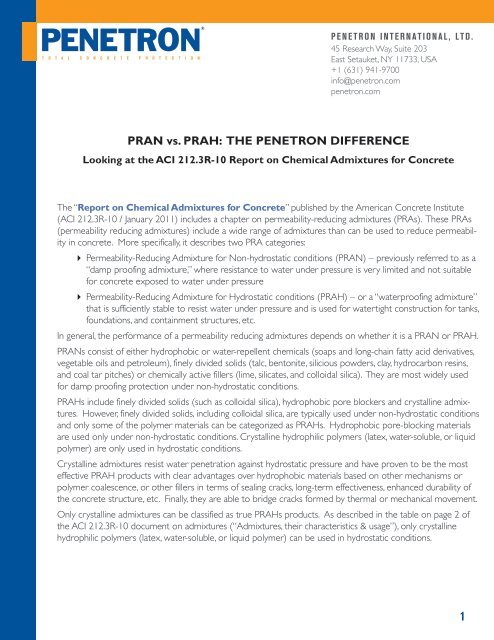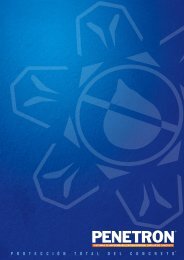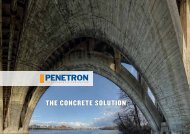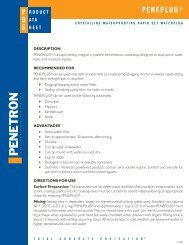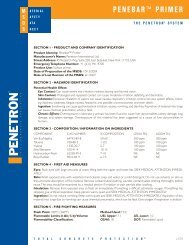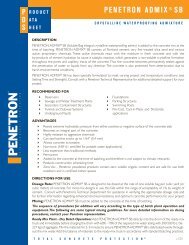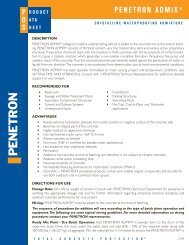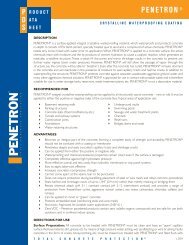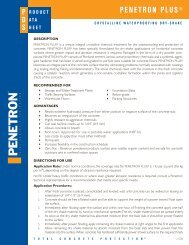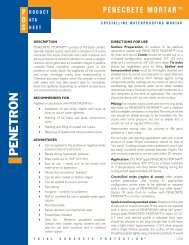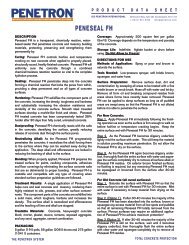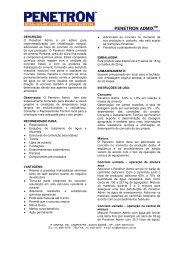PRAN vs. PRAH: THE PENETRON DIFFERENCE
PRAN vs. PRAH: THE PENETRON DIFFERENCE
PRAN vs. PRAH: THE PENETRON DIFFERENCE
You also want an ePaper? Increase the reach of your titles
YUMPU automatically turns print PDFs into web optimized ePapers that Google loves.
T O T A L C O N C R E T E P R O T E C T I O N®<strong>PENETRON</strong> INTERNATIONAL, LTD.45 Research Way, Suite 203East Setauket, NY 11733, USA+1 (631) 941-9700info@penetron.compenetron.com<strong>PRAN</strong> <strong>vs</strong>. <strong>PRAH</strong>: <strong>THE</strong> <strong>PENETRON</strong> <strong>DIFFERENCE</strong>Looking at the ACI 212.3R-10 Report on Chemical Admixtures for ConcreteThe “Report on Chemical Admixtures for Concrete” published by the American Concrete Institute(ACI 212.3R-10 / January 2011) includes a chapter on permeability-reducing admixtures (PRAs). These PRAs(permeability reducing admixtures) include a wide range of admixtures than can be used to reduce permeabilityin concrete. More specifically, it describes two PRA categories: Permeability-Reducing Admixture for Non-hydrostatic conditions (<strong>PRAN</strong>) – previously referred to as a“damp proofing admixture,” where resistance to water under pressure is very limited and not suitablefor concrete exposed to water under pressure Permeability-Reducing Admixture for Hydrostatic conditions (<strong>PRAH</strong>) – or a “waterproofing admixture”that is sufficiently stable to resist water under pressure and is used for watertight construction for tanks,foundations, and containment structures, etc.In general, the performance of a permeability reducing admixtures depends on whether it is a <strong>PRAN</strong> or <strong>PRAH</strong>.<strong>PRAN</strong>s consist of either hydrophobic or water-repellent chemicals (soaps and long-chain fatty acid derivatives,vegetable oils and petroleum), finely divided solids (talc, bentonite, silicious powders, clay, hydrocarbon resins,and coal tar pitches) or chemically active fillers (lime, silicates, and colloidal silica). They are most widely usedfor damp proofing protection under non-hydrostatic conditions.<strong>PRAH</strong>s include finely divided solids (such as colloidal silica), hydrophobic pore blockers and crystalline admixtures.However, finely divided solids, including colloidal silica, are typically used under non-hydrostatic conditionsand only some of the polymer materials can be categorized as <strong>PRAH</strong>s. Hydrophobic pore-blocking materialsare used only under non-hydrostatic conditions. Crystalline hydrophilic polymers (latex, water-soluble, or liquidpolymer) are only used in hydrostatic conditions.Crystalline admixtures resist water penetration against hydrostatic pressure and have proven to be the mosteffective <strong>PRAH</strong> products with clear advantages over hydrophobic materials based on other mechanisms orpolymer coalescence, or other fillers in terms of sealing cracks, long-term effectiveness, enhanced durability ofthe concrete structure, etc. Finally, they are able to bridge cracks formed by thermal or mechanical movement.Only crystalline admixtures can be classified as true <strong>PRAH</strong>s products. As described in the table on page 2 ofthe ACI 212.3R-10 document on admixtures (“Admixtures, their characteristics & usage”), only crystallinehydrophilic polymers (latex, water-soluble, or liquid polymer) can be used in hydrostatic conditions.1
®T O T A L C O N C R E T E P R O T E C T I O NAdvantages of a <strong>PRAH</strong>The proprietary active ingredients in a crystalline <strong>PRAH</strong> react with water and cement particles in the concrete toincrease the density of calcium silicate hydrate (CHS) and/or generate pore-blocking deposits in the existingmicro-cracks and capillaries to resist water penetration. As hairline cracks form over the life of the concrete,crystalline admixtures continue to activate in the presence of moisture, sealing additional gaps.As noted in the ACI report: “To resist hydrostatic pressure, <strong>PRAH</strong>s employ a pore-blocking mechanism fromcrystalline growth, polymer coalescence, or other filler, although the ability to withstand hydrostatic pressure willdepend on how completely the pores are blocked and the stability of the deposits under pressure. The distinctionshould be made based on the admixture’s demonstrated ability to reduce water penetration under the expectedservice conditions.”The pore-blocking mechanism is based on proprietary active chemicals blended with a mixture of cement andsand.Because <strong>PRAH</strong>s based on polymer coalescence or other fillers are unable to withstand high hydrostatic pressure,they cannot be considered “true” <strong>PRAH</strong> admixtures. The pore-blocking mechanism in crystalline-based <strong>PRAH</strong>s isbased on proprietary active chemicals blended with a mixture of cement and sand, which respond permanentlyand comprehensively to moisture and changes even when exposed to high hydrostatic pressure.Unlike hydrophobic materials – such as the <strong>PRAN</strong> products discussed above – crystalline admixtures are hydrophilic.The crystalline deposits develop throughout the concrete, becoming a permanent part of the concretemass when exposed to water. <strong>PRAH</strong>s make external waterproofing membranes redundant, even for concreteunder high hydrostatic pressure.<strong>PENETRON</strong> <strong>PRAH</strong> Technology: Testing Under High Hydrostatic ConditionsSimilar to the general process described for crystalline <strong>PRAH</strong> admixtures above, the active ingredients in PEN-ETRON ADMIX ® react with the by-products of cement hydration in the presence of water in fresh and hardenedconcrete structures. These reactions extend hydration and form additional calcium silicate hydrate moleculesalong with insoluble crystals throughout the concrete matrix. These insoluble formations precipitate within thenatural pores and capillaries of the concrete mix to dramatically reduce the permeability of the concrete.When <strong>PENETRON</strong> ADMIX ® is added to concrete during batching, the resulting crystalline lattice also permanentlyseals hairline cracks as they develop over the lifetime of the concrete.<strong>PENETRON</strong> products have been extensively tested in the laboratory under high hydrostatic conditions (includingASTM D5084, NBR 10.787/94, USAE CRD C48, BS EN 12390-8 and DIN 1048-5 Water Permeability). In thesetests, the resulting crystalline lattice effectively reduces the permeability of the concrete samples when comparedto the control samples; leakage in the treated concrete was eliminated, even when exposed to high hydrostatictest conditions.The following examples show the improvements from the permeability-reducing reactions of <strong>PENETRON</strong>ADMIX ® under high hydrostatic conditions.2
®T O T A L C O N C R E T E P R O T E C T I O NTesting Water Penetration Under Pressure – NBR 10.787/94101.5 psi head pressureAfter being exposed to a pressure of 101.5 psi (234.1 ft of head pressure) for four weeks, the <strong>PENETRON</strong>crystalline reaction had almost completely reduced concrete permeability and eliminated all leakage.3
®T O T A L C O N C R E T E P R O T E C T I O NMSZ EN 12390-8:2009 (DIN 1048)Samples treated with <strong>PENETRON</strong> ADMIX ® (marked with a P) and two control samples are shown. All sampleswere exposed to a head pressure of 72.5 psi for 72 hours. This photo was taken immediately after splitting thesamples in half to measure the depth of water penetration. The <strong>PENETRON</strong> ADMIX ® samples exhibited a 94.4%reduction in water penetration compared to the control samples.Recent <strong>PENETRON</strong> <strong>PRAH</strong> Projects<strong>PENETRON</strong>’s permeability reducing technology has been proven in demanding high hydrostatic conditions in thefield with the highest success. Several recent projects highlight the effectiveness of <strong>PENETRON</strong> permeabilityreducingadmixtures in high hydrostatic service conditions: South Cobb Tunnel Lift Station near Atlanta, GA Tower Street Reservoir – an eight-million gallon water holding tank in Harrisonburg, VA National Road Bikeway Tunnel near St. Clairsville, OH Singapore Airport / Terminal 3, Singapore Gardens by the Bay, Marina Bay, Singapore Corredor Duarte, Santo Domingo, Dominican Republic Chennai International Airport, India4
®T O T A L C O N C R E T E P R O T E C T I O NSouth Cobb Tunnel Lift StationThis structure is a 212-feet deep shaft thatlifts sewage from over 32,000 LF oftunnels in Cobb County, GA. At theseextraordinary depths, the design – a wetwell within a dry well – required that thepermeability of the concrete be extremelylow to eliminate all concerns with leakingsewage from the wet well to the dry well(which is used by maintenance personnel).The ground water pressure at 212-feetelevations and the broken and shatteredpieces of inconsistent bedrock were majorwaterproofing concerns. <strong>PENETRON</strong>ADMIX ® was specified as the <strong>PRAH</strong> forthis project; over 20,000 cubic yards weretreated and successfully waterproofed.Tower Street ReservoirLocated in Harrisonburg, VA, thisnew eight-million gallon concretewater holding tank replaced aleaking in-ground concrete-linedreservoir. Built by the CromCorporation, the new tankfeatures the permeabilityreducingbenefits of<strong>PENETRON</strong>’s integral crystallinewaterproofing technology. Constructionof the new tank incorporateda <strong>PENETRON</strong> ADMI X ®Enhanced Shotcrete (PAES)application to protect thereinforcing steel embedded inthe concrete shell and to eliminateall leakage from the over70-feet high structure. PE-NETRON ADMI X ®’s ability toreduce concrete permeabilityunder high hydrostatic conditionsimproved Harrisonburg’s waterdistribution system by eliminatingwater leakage.5
®T O T A L C O N C R E T E P R O T E C T I O NNational Road Bikeway Tunnel RehabilitationOver 100 years old, the National RoadBikeway tunnel was plagued by groundwaterinfiltration and damage. First built in1902 in an area of thinly bedded, faintlyporous, weak shale with significantgroundwater inflows, the main focus ofthe rehabilitation project was to controlwater infiltration and the subsequent icebuild-up and damage. The ability of the<strong>PENETRON</strong> technology to reduce thepermeability of the new shotcrete liner,even against high hydrostatic head pressure,exceeded the design team’s expectation.The ice and water infiltration problemwas wholly eliminated.Singapore ChangiAirport /Terminal 3More than an air transportationhub, theChangi Airport is asymbol of national prideand a benchmark forservice excellence.Terminal 3 featuresinnovative passengerfacilities and modernarchitecture. 140,000m³ of concrete wastreated with PEN-ETRON ADMIX ® , alongwith <strong>PENETRON</strong> ®slurry and PENECRETEMORTAR.6
®T O T A L C O N C R E T E P R O T E C T I O NGardens by the Bay, MarinaBay, SingaporeThe distinctive waterfront gardensare an all-weather ‘edutainment’space, an architectural icon, ahorticultural attraction, and ashowcase of sustainable energytechnology – with large cooledconservatories replicating specificclimates to house an uncommonrange of flowers and plants. Theproject represented severe waterproofingchallenges as it is builtentirely on reclaimed land and rightnext to the ocean. 18,300 m³ ofconcrete were cast with PEN-ETRON ADMIX ® in the base slaband walls; PENEBAR SW-55 wasused in the construction joints andPENESEAL PRO ® on the mountainwalls.Corredor Duarte, SantoDomingo, DominicanRepublicThe Corredor Duarte Tunnel,the newest tunnel in theDominican Republic providesa rapid connection betweenSanto Domingo and the restof the country. About 1,200m (4,000 ft) in length, thetunnel plays a key role inrelieving chronic trafficcongestion in the capitol. Amuch thinner shotcrete layerwas applied immediatelybehind the tunnel boringmachine, creating a natural load-bearing ring and minimizing deformation of the surrounding layers of rock. PEN-ETRON ADMIX ® was used to reduce the permeability of the shotcrete walls. PENEBAR SW-55 was used toseal the concrete construction joints. In total, 45 tons of <strong>PENETRON</strong> ADMIX ® and 2,300 meters of PENEBARSW-55 were used.7
®T O T A L C O N C R E T E P R O T E C T I O NChennai InternationalAirport, IndiaExpanded and modernized tomeet higher traffic demands, theChennai International Airportexpanded the internationalterminal, and added a newdomestic passenger terminal, amulti-level car parking facility anda parallel runway to boostcapacity to 16 million passengersa year. Located adjacent to theBay of Bengal, the airport’sfluctuating ground water levels(-10 m in summer and -3 mduring monsoon) demanded thorough waterproofing of all concrete structures and the concrete joints in thebasement (10m deep). In total, 125 tons of <strong>PENETRON</strong> ADMIX ® were used in the basement slabs and retainingwalls; 15,000 meters of PENEBAR SW-45 swellable-type waterstops were used to prevent water ingress alongthe concrete joints.8


